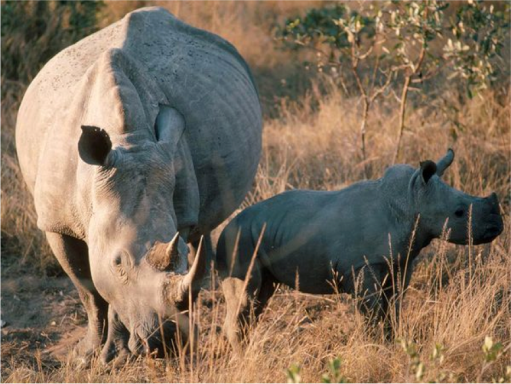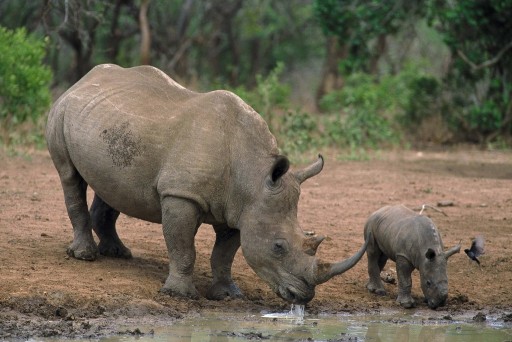There are a number of conservationists and independent rhino farmers lobbying for the international ban on rhino horn trading to be removed, and for a legal market to be created. The South African government is currently considering this option, and could put forward a proposal at the 2016 Convention of Trade in Endangered Species of Wild Fauna and Flora (CITES). This would allow for the legal sale of rhino horns. However, the support of two-thirds majority from the 178 member states of CITES would be required.
Poachers killed 688 rhinos in South Africa last year. This was mainly in the Kruger National Park, where the largest population of white rhinos is housed. In April 2013, the government released a press statement indicating that 203 rhinos had been killed since the start of the year. Poaching numbers in South Africa have just about doubled each year for the past five years. According to scientists, if poaching continues to accelerate, all of Africa’s rhinos in the wild will be extinct in about 20 years.

Rhino horn is worth more than gold on the black market, which places rhinos in the centre of a bloody poaching war. (Image courtesy of Brent Stirton/ National Geographic)
Rhino poaching is widely known to be a major problem in South Africa. There have been proposals to lift the ban since 1977, igniting debate concerning whether a legal market would actually reduce poaching. It is difficult to draw a definite conclusion about the type of outcomes a legal market would evoke. Chris Galliers, the Biodiversity Programme Manager of WESSA Rhino Conservation said, “There may be pros and cons to legalizing the trade, and perhaps it may not be a case of whether to trade or not, but how to trade.”
Advocates look to a legal market as the solution to poaching. A tightly controlled and regulated market could lend support to the persistent Asian demand, and, if it is effectively administered, provide a cheaper, wiser and more reliable option rather than trading in the black market with criminal cartels. This would attract buyers to the legal trade, and hopefully terminate the illegal market. However, as Galliers points out, there may not be an efficient enough mechanism which could effectively distinguish between a legally traded horn and an illegal one – “will this not end up ‘legalizing’ illegal rhino horn stocks?”
Advocates propose that, in order for a legal market to be effective, there must be an independent body that would act as a central selling organization. This organization would report to CITES and control the selling of rhino horns to registered buyers. A percentage of the income from sales would go towards conservation efforts and strengthening initiatives against poaching. Galliers said, “Currently the hunting of rhinos may offer the most controllable opportunity for the trade in rhino horn as a trophy rather than for use.” Perhaps a legal market could also prove to be more humane to rhinos, due to the fact that rhino horn is made of keratin, which is also found in human hair. Keratin will grow back after being cut. A minimal risk to the rhinos would be sedating them and shaving off their horns, opposed to hundreds of rhinos being slaughtered for their horns, and then left to die.
Opponents of a legal market argue that lifting the ban would stimulate black market trade that is already booming in parts of Asia. Rhino horn is sold for 65 000 dollars per kilogram, this is more than its weight in gold or cocaine. Galliers explains how it is unlikely for poachers to halt their trade in accordance to the creation of a legal market: “Will the current poacher give up ‘free’ access to a resource he currently enjoys? The black market trade and all those involved will do their best to remain ‘employed’ in this lucrative business – they are acting illegally, and so who says that if trade is opened that they will come out and expose themselves?” Of course criminal syndicates could still arrange ways around the legal market. They could do this even through simple marketing strategies, as Galliers demonstrates: “Illegal traders may shift market preference as we have seen with other wildlife products, for example, they market the fact that wild rhino horns have great medicinal properties and therefore more value than farmed ones.”
There are a number of conservation groups opposing a legal market. They believe that legislation would pump demand for rhino horn to a point which the market would be unable to sustain. Criminals markets would then flourish parallel to the legal one, as is the case with abalone in South Africa being severely threatened due to poaching. Galliers points out that creating a legal market could be both detrimental and beneficial, and we cannot say for certain. We still do not fully understand the illegal trade. Galliers reiterates how there is a lack of accurate information regarding the nature and the scale of the demand. “Can supply meet demand? Will we not be fueling a demand that we will never be able to meet? We need to be targeting the reduction of demand and breaking down the myths associated with the use of rhino horn.”

A ranger holds a rhino horn that was taken from a dead rhino shot by poachers in Kenya. In Vietnam, a rhino horn is believed to have curative powers, and is sold for up to $65 000 dollars on the black market. (Image courtesy of Roberto Schmidt/APG/Getty Images)
An example of an effective legal market of animal parts, which also encouraged conservation, would be the trade of crocodile skins. During the 1980s, this trade allowed a shift toward sustainable crocodile ranching, opposed to wild crocodiles being slaughtered. However, the example of ivory is a very different case. In 2008, China had legally bought ivory from stockpiles from Botswana, Namibia, Zimbabwe and South Africa. However, there was a significant spike in illegal ivory sales in China after this. The Chinese government purchased ivory for 157 dollars per kilogram, but sold it for no less than 1500 dollars per kilogram. Then there were retailers that traded ivory products for about 7000 dollars, according to an Environmental Investigation Agency report. This same report states that up to 90% of ivory entering the market in China is illegal. Illegal ivory is now cheaper than legal ivory, which has led to the greatest surge in poaching since it was banned in 1989. In dealing with the possibility of legalizing the trade in rhino horn, Galliers has pointed out: “We need to learn lessons from the disastrous sale of ivory.”
Opponents of the legal trade are concerned that governments would be unable to effectively provide police support for the rhino horn market, and argue that corruption is very likely to be a problem. Police arrested four South African National Parks officials last year, as they were connected with rhino poaching. There is an obvious need for government to be offering more protection against rhino poaching. Galliers points out a need for a less fragmented and more efficient approach to fight poaching, with increased investment into the acquisition. There must be access to more reliable information, as well as a selective process of people who are “employed with the right qualifications, skills and attributes for their job”. Galliers also highlights the need for an increased capacity to deal with the situation, “from field rangers through to forensic specialists”. There must also be an improved judicial system, “where rhino poaching is elevated in significance in terms of prosecution time and sentences.” There must also be a greater political will to end rhino poaching. Galliers explains how there must be greater pressure from international and diplomatic levels; he uses putting pressure on Mozambique and demand states as an example. There should be a well run and accurate database of rhinos in South Africa, as well as improved education and awareness. Galliers said, “Government needs to play their role at every level, as they hold the key to making the biggest difference. However, this does not mean that civil society should not shoulder some responsibility as well.”
Legalizing the trade of rhino horn is indeed a highly controversial conservationist issue. We may not know exactly what the demand for rhino horn really is, and we do not know how opening a legal market for rhino horn would affect this demand. However, we know that if the door to a legal market is opened, it would be impossible to close that door if need be.

Government must take more effective action against rhino poaching, however, rhino poaching is a major issue that civil society should be aware about. (Image courtesy of James P. Blair/ National Geographic)


